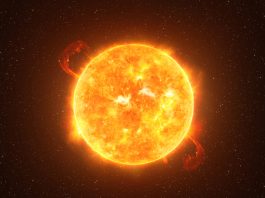Researchers discover a remarkable link between the number of nearby exploding stars, called supernovae, and life on Earth.
New evidence demonstrates a close connection between the fraction of organic matter buried in sediments on Earth, and changes in supernovae occurrence. This correlation is evident during the last 3.5 billion years and can be noticed in greater detail over the past 500 million years.
This association indicates that supernovae have set essential conditions under which life on Earth had to exist. This is established in a new research article published in the scientific journal ‘Geophysical Research Letters’ by senior researcher Dr Henrik Svensmark, DTU Space.
Link between supernovae and life on Earth
According to the article, an explanation for the observed link between supernovae and life on Earth is that supernovae influence the Earth’s climate. A high number of supernovae occurrences results in a cold climate with a juxtaposed temperature difference between the equator and polar regions.
This results in strong winds and ocean mixing, which is vital for delivering nutrients to biological systems. High nutrient concentration leads to larger bio-productivity and a more extensive burial of organic matter in sediments. A warm climate has weaker winds and results in less mixing of the different oceans, a diminished supply of nutrients, a smaller bio-productivity, and less burial of organic matter.
“A fascinating consequence is that moving organic matter to sediments is indirectly the source of oxygen,” explained author Henrik Svensmark. “Photosynthesis produces oxygen and sugar from light, water and CO2. However, if organic material is not moved into sediments, oxygen and organic matter become CO2 and water. The burial of organic material prevents this reverse reaction. Therefore, supernovae indirectly control oxygen production, and oxygen is the foundation of all complex life.”
A measure of the concentration of nutrients in the ocean over the last 500 million years correlates reasonably with the variations in supernovae frequency. The concentration of nutrients in the oceans is observed by measuring trace elements in pyrite (FeS2, also called fool’s gold) embedded in black shale, which is sedimented on the seabed. Estimating the fraction of organic material in sediments is possible by measuring carbon-13 relative to carbon-12. Since life prefers the lighter carbon-12 atom, the amount of biomass in the world’s oceans changes the ratio between carbon-12 and carbon-13 measured in marine sediments.
“The new evidence points to an extraordinary interconnection between life on Earth and supernovae, mediated by the effect of cosmic rays on clouds and climate,” explained Svensmark.
The link to Earth’s climate
Previous studies by Svensmark and colleagues have demonstrated that ions help the formation and growth of aerosols, thereby influencing cloud fraction. Since clouds can regulate the solar energy that reach the Earth’s surface, the cosmic-ray-cloud link is important for climate. Empirical evidence shows that Earth’s climate changes when the intensity of cosmic ray’s shifts. Supernovae frequency can vary by several hundred percent on geological time scales, and the resulting climate changes are considerable.
“When heavy stars explode, they produce cosmic rays made of elementary particles with enormous energies,” Svensmark concluded. “Cosmic rays travel to our solar system, and some end their journey by colliding with Earth’s atmosphere. Here, they are responsible for ionizing the atmosphere.”









